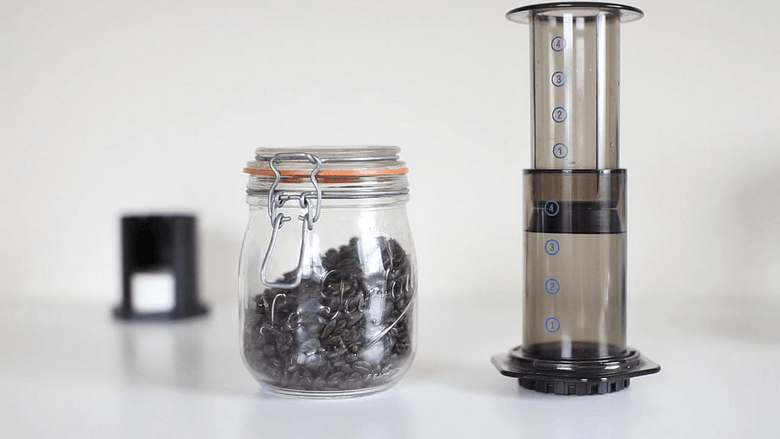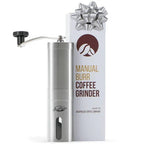There are a lot of “press” style coffee brewers out there and sifting through all the information can be a bit confusing and difficult. If you’re trying to choose one to purchase, I’m going to make things easy for you by letting you know the two brewers of this style that you should keep your eye one.
The Aeropress and the french press.
Despite both having “press” in the name, the Aeropress and french press work very differently. They brew coffee with different qualities, they thrive in different scenarios, they fit different lifestyles.
I’m going to help you determine which brewer would be a better fit for your unique circumstances and taste preferences. Let’s get started!
Design And Durability
Both the Aeropress and the french press feature a simple design that only uses a few parts. This simplicity makes both of these brewers easy to clean, use, and maintain. They’re often buy-it-for-life items.
French presses often have a metal frame, heat proof glass carafe, plastic or metal lid, and a metal filter attached at the end of a rod. You may have to eventually replace the glass carafe - accidents happen - but the rest of the brewer is built to serve you for a lifetime. Just don’t run your press over with a car and you should be alright.
French presses range in size from 8 oz to 48 oz and the larger sizes can still be used to make smaller amounts of coffee.
Read: Take Your Aeropress Camping For Easy Outdoor Coffee
This Aeropress is made with a food-safe rubber that’s extremely durable under pressure and is built with even fewer parts: a brewing chamber, plunger, and filter cap. This brewer can handle just about anything - including being run over with a car. Don’t ask how I know.
The Aeropress comes in only one size: 8 ounces. It’s small, but it’s part of the charm that I’ll show you in a minute.
If you know you may be a little too clumsy to use a glass french press every day, the Aeropress will put your anxiety to rest. If the sound of an 8 oz brewer isn’t appealing, opt for a larger french press.
Brewing Ease Of Use
Both the Aeropress and the french press are easy to use and forgiving but in different ways.
Let’s start with how they’re similar. Both brewers are what we call “immersion brewers”. Basically, the water and coffee grounds sit together for a period of time before they are filtered. The filtering step is something you, the coffee lover, initiate.
The main difference between Aeropress and french press brewing can easily be seen in the specific techniques and processes.
The brewing process for a French press typically goes something like this: you immerse coarse grounds and hot water in the glass carafe. After four minutes is up, you plunge the filter, pour the coffee out, and enjoy.
This stainless steel mesh filter attached at the end of a metal rod separates the grounds from the brewed coffee as you plunge it down. It’s easy, it’s painless.
Read: The Ultimate Guide To French Press Coffee
The Aeropress incorporates another element in the brewing process: pressure. This new element gives the Aeropress a lot of flexibility with how it makes coffee and makes it a connoisseur’s paradise. However, it doesn’t take away from the simple process that anyone can follow.
You immerse medium to coarse grounds and hot water in the brewing chamber. Once 1-3 minutes has passed (depending on your grind size), you press down the plunger. This generates a lot of pressure and forces the coffee through the filter.
The Aeropress has two main orientations that you can use to brew with. The “regular” orientation can be used by attaching the filter cap to the brewing chamber and setting it on top of your mug.
The “inverted” orientation (my personal favorite) can be used by attaching the plunger to the brewing chamber and leaving the filter cap off so that the opening is face-up. This keeps coffee from draining through the filter prematurely, but means you have to flip the Aeropress over onto your mug. It’s scary the first few times, but you get the hang of it.
Read: The Ultimate Guide To Aeropress Coffee
Overall, neither the french press or the Aeropress is complicated or difficult, but they are different. The french press is the clear winner when it comes to sheer, consistent simplicity. The Aeropress is an excellent choice if you’re a tinkerer or if you like to mix it up with how you brew your coffee.
Coffee Flavor And Quality
Now we’re to the good stuff: the actual coffee itself.
I’ve got great news for you: both the Aeropress and french press can make stellar coffee that’s rich, balanced, and deeply satisfying. There are some nuance differences in the flavor though that you’ll want to keep in mind.
For starters, the metal filter of the french press generally produces coffee with a full body and full flavor. Natural oils and microscopic coffee grounds don’t get held back by the mesh filter, which creates a feeling of heaviness and fullness and boosts flavor. These two things tend to reduce specific flavor clarity but result in a more robust, rounded flavor.
Since french press recipes are pretty static (coarse grind, 4 minutes), you can be confident that your coffee will be rich, balanced, and rounded every single time.
The Aeropress always ships with paper filters. These filters produce coffee that’s crisper, brighter, and cleaner than that of the french press filter. Sadly, the natural oils and micro-ground - which give off tons of flavor - aren’t allowed into the final mug. Many people like this cleaner, lighter cup, but if you’re still in the mood for a richer, fuller mug, there are stainless steel Aeropress filters too.
Aeropress brewing recipes are very adaptable so there’s a lot of room for playing around and still getting excellent coffee. A recipe using a fine grind setting and a short amount of time will produce a bright, crisp cup of coffee. A recipe using a coarse grind and a long amount of time will brew coffee closer to that of a french press. Both options are delicious in their own way.
When it comes to flavor and quality, you cannot make a wrong choice here.
Versatility
Both brewers have their advantages when it comes to versatility.
French press brewers make great hot coffee, but really only in one way. However, they’re also great carafes for making cold brew coffee or brewing pour over coffee into.
The Aeropress, on the other hand, can make hot coffee multiple ways. You can make coffee that’s heavy and bold, coffee that’s light and crisp, and even coffee that’s very close to espresso.
However, the Aeropress doesn’t make for a good cold brew coffee maker and it’s definitely not big enough to be the carafe for pour over coffee. You can use it though to make Shaken Iced Aeropress Coffee.
Travel-Friendliness
Technically, both brewers are manual, non-electric, and can be used anywhere in the world. But I would say that one of them is far more suited for travel than the other.
French presses are larger and often built with breakable glass. I’ve road tripped plenty of times with my press without incident, but I was being extremely careful to keep it safe. I wouldn’t dare to fly with one.
In many ways, the Aeropress is the ultimate travel coffee brewer. It’s light, small, quick and easy to use, and is nearly indestructible. It’s great for international flights, mountain hikes, and valley campsites.
Sure, it only brews 8 oz of coffee at a time, but that’s really its own travel flaw.
The difference between Aeropress and french press travel-readiness is clear: the Aeropress is the clear winner in every way except batch size.
Which Is Right For You?
I cannot decide which brewer is right for your particular lifestyle or taste preferences, but I’ve given you everything you need to know to make that decision. Only you can decide.
Will you go with the large, beautiful brewer that makes simple and robust hot & cold coffee? Or will you go with the smaller, travel-ready brewer that makes several styles of hot coffee?
Don’t stress: there’s really no wrong answer - at least, as long as you're using coffee worthy of the brewers.
We believe there's no alternative to freshly roasted, specialty-grade beans. They're more tasty, sweeter, more balanced, and have a wider range of flavors compared to stale beans from the grocery store.




